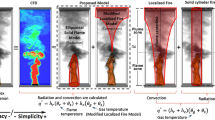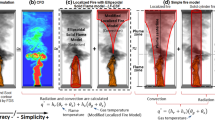Abstract
In order to analyze thermal safety of fireworks and crackers, thermal explosion models of three kinds of sphere fireworks and crackers with different structures are achieved on the basis of thermal explosion theory, and thermal resistance of shell and effective Biot number are deduced as for boundary conditions. Two models are calculated with target-shooting method in Matlab program, and the rationality is proved through comparison of numerical solution and classical solution. Meanwhile, calculation steps are shown about a type of firework. The study has a great significance to thermal safety analysis of fireworks and crackers.


Similar content being viewed by others
References
Nie JH. Study on safety production core issue of fireworks and firecrackers. J Saf Sci Technol. 2010;6:66–7.
Huang ZH, Cui HT. Accident analysis and fire safety management in the process of cracker production. Initiat Propell. 2010;1:4–49.
Zhang GH, Tan AX, Jiang ZC. Experimental study on transport dangerous classification of display shells. Initiat Propell. 2008;9:53–6.
Zayed MA. Stability studies of double-base propellants with centralite and malonanilide stabilizers using MO calculations in comparison to thermal studies. J Hazard Mater. 2010;179:34–8.
G.W. Zhou. Thermal safety study of fireworks and crackers, Ms.D. thesis. Beijing Institute of Technology, Beijing, 2010.
Zhang GH, Tan AX, Jiang ZC, Qiu ZS, Xiao JY. Experimental study on time/pressure tests for pyrotechnic composition in fireworks. J Insp Quar. 2010;20:6–9.
Roduit B, Xia L, Folly P, Berger B, Mathieu J, Sarbach A, Andres H, Ramin M, Vogelsanger B, Spitzer D, Moulard H, Dilhan D. The simulation of the thermal behavior of energetic materials based on DSC and HFC signals. J Therm Anal Calorim. 2008;93:10–143.
Chou YC, Hsieh TF, Hsieh YC, Lin CP, Shu CM. Comparisons of MWCNTs and acidified process by HNO3 on thermal stability by DSC and TG-FTIR. J Therm Anal Calorim. 2010;102:105–6.
Lei YJ, Zhu CH, Hu RZ, Wang BZ. Kinetics of the exothermic decomposition reaction and critical temperature of the thermal explosion for 7-amino-4,6-dinitrobenzofuroxan (ADNBF). Chin J Explos Propell. 2002;2:44–8.
Zhang H, Hu JY, Hu RZ, Zhao FQ, Gao HX. A new method based on the non-isothermal kinetic equation to estimate the critical temperature of thermal explosion for energetic materials using non-isothermal DSC. J. Shanghai Jiaotong Univ (Sci). 2011;16:247–9.
Zhao FQ, Gao HX, Hu RZ, Lu GE, Jiang JY. A study of estimating the safe storage life, self-accelerating decomposition temperature and critical temperature of thermal explosion of double-base propellant using isothermal and non-isothermal decomposition behaviours. Chin Chem Lett. 2006;17:11–667.
Wang P, Qin CS. A calculation of the critical parameters of thermal explosion for the finite cylinder of energetic materials. Explos Shock Wave. 2003;23:6–158.
Feng CG. Thermal explosion theory. Beijing: Science Press; 1988.
Du X, Feng CG, Du ZM. Critical parameters for the thermal explosion problem of exothermic materials with shells. J Beijing Inst Technol. 1996;16:6–37.
Guo PJ, Hu RZ, Zhang H, Xia ZM. Estimation of critical rate of temperature rise for thermal explosion of first order autocatalytic decomposition reaction systems by using non-isothermal DSC. Chem Res Chin Univ. 2004;20:163–6.
Zhang H, Hu RZ, Zhao FQ, Gao HX, Ma HX. Estimation of critical temperature of thermal explosion for trinitromethyl explosives by non-isothermal DSC. Chem Res Chin Univ. 2010;26:5–436.
Wang LL, Xie JB, Zhou JM, Wang WL. Study on the simulation and verification methods for the identification of heat explosive accidents in high risk Processes. China Saf Sci J. 2009;19:84–8.
Roduit B, Folly P, Berger B, Mathieu J, Sarbach A, Andres H, Ramin M, Vogelsanger B. Evaluating SADT by advanced kinetics-based simulation approach. J Therm Anal Calorim. 2008;93:10–153.
Du X, Feng CG. Critical parameters for the thermal explosion of exothermic systems having two-dimensional geometries. J Beijing Inst Technol. 2004;14:37–9.
Wang P, Du ZM. Random nature of thermal explosion criticality of exthermic system. China Saf Environ. 2007;7:115–8.
Sun ZH, Wang Y. Evaluation of autoignition of organic peroxides with small sample mass. Chin J Appl Chem. 2005;22:1–6.
Zhao FQ, Hu RZ, Gao HX. A simple method based on Harcourt-Esson’s Equation to estimate the critical temperature of thermal explosion for energetic materials using non-isothermal DSC. Chin J Chem. 2009;27:101–7.
Yang SM, Tao WQ. Heat transfer theory. Beijing: High Education Press; 2006.
Roduit B, Brogli F, Mascarello F, Schwaninger M, Glarner T, Wiss J, Luginbuhl M, Williams C, Beuse P. Eestinmation of TMRad using kinetics parameters derived from DSC-investigation of thermal behavior of 3-methy-4-nitrophenol. J Therm Anal Calorim. 2009;94:1–9.
Qin CS, Duan QS. A new method for computing the critical parameters of thermal explosion. Energ Mater. 1998;6:6–8.
Qin CS, Zhang TJ. Thermal explosion critical state parameters estimated with variational method. Explos Shock Wave. 2008;12:106–7.
Z.M. Du. Thermal ignition of exothermic reaction system in limited space, Ph.D. thesis. Beijing Institute of Technology, Beijing, 1993.
Li JH. Study on the relationship between the critical parameters of thermal explosion and the long-to-diameter of explosive cylinder. Energ Mater. 2005;3:34–6.
Roduit B, Dermaut W, Lunghi A, Folly P, Berger B, Sarbach A. Advanced kinetics-based simulation of time to maximum rate under adiabatic condition. J Therm Anal Calorim. 2008;93:11–163.
Yang BG, Shi H. A thermal stability criterion for heat conduction in multilayer composite solids. J Heat Trans. 2009;131:11–6.
Xu F, Sun LX, Zhang J, Qi YN, Yang LN, Ru HY, Wang CY, Lan XF, Jiao QZ, Huang FL. Thermal stability of carbon nanotubes. J Therm Anal Calorim. 2010;102:10–28.
Acknowledgements
We would like to express our gratitude to Guangwei Zhou for his enthusiastic help in this study.
Author information
Authors and Affiliations
Corresponding author
Rights and permissions
About this article
Cite this article
Liu, H., Qian, X., Du, Z. et al. Thermal explosion model and calculation of sphere fireworks and crackers. J Therm Anal Calorim 110, 1029–1036 (2012). https://doi.org/10.1007/s10973-011-2087-3
Received:
Accepted:
Published:
Issue Date:
DOI: https://doi.org/10.1007/s10973-011-2087-3




